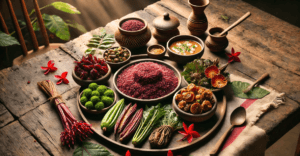Jharkhand’s Indigenous Chefs Revive Tribal Cuisine in City Restaurants
Indigenous entrepreneurs in Jharkhand are introducing traditional tribal cuisine to city restaurants, preserving their cultural heritage. Ajam Emba, founded by Aruna Tirkey, serves dishes made from local ingredients like roselle, mahua flowers, and red rice. Customers visit to reconnect with childhood flavors. Mandi Eddpa, run by Kapil Vinod Toppo, blends tribal and Korean cuisine, attracting both young and older diners.
The Open Field, managed by Manisha Oraon, offers dishes like jirhul flower mashed potatoes and mahua kheer while documenting Indigenous recipes. These restaurants support local farmers and revive forgotten, eco-friendly foods. Researcher Soumik Banerjee says they help restore traditional diets. Tirkey notes changing perceptions—once seen as food of hardship, tribal cuisine is now a source of pride. With 32 recognized tribes, Jharkhand’s Indigenous chefs are bringing their food culture into the urban mainstream.

Jharkhand’s Indigenous Chefs Revive Tribal Cuisine in City Restaurants
In Jharkhand, a state in eastern India, tribal chefs and entrepreneurs are reviving their rich culinary heritage by bringing traditional dishes to city restaurants. Their mission is simple yet powerful: to share the unique flavors of their Indigenous culture with urban communities while preserving their roots. By using locally sourced, seasonal ingredients, these restaurants not only introduce diners to forgotten recipes but also support rural farmers and promote sustainable food practices.
Ajam Emba: A Taste of Tradition
In Ranchi, Jharkhand’s capital, Aruna Tirkey, a member of the Oraon tribe, runs a restaurant called Ajam Emba, which means “delicious taste” in the Kurukh language. The menu features dishes made with seasonal vegetables, grains, and flowers such as roselle (kudrum), Centella (beng), Indigofera (jirhul), and mahua blossoms. Staples like red rice and mahua-based desserts highlight the simplicity and nutrition of tribal cooking. For many customers, like regular visitor Gaurav Marandi, the food evokes childhood memories. His mother, Rut Kachhap, shares that these traditional flavors are hard to find in cities, making the restaurant a cherished spot for reconnecting with their culture.
Mandi Eddpa: Blending Cultures
Another Ranchi-based eatery, Mandi Eddpa, creatively fuses tribal cuisine with Korean dishes. Owner Kapil Vinod Toppo was inspired during his time working in South Korea, where he noticed parallels between his community’s maad-bhaat (a rice-based dish) and Korean ramen bowls. His restaurant now attracts younger crowds eager to try Korean flavors, while older generations appreciate the tribal recipes. This mix of old and new has turned the restaurant into a bridge between cultures, proving that traditional food can adapt to modern tastes without losing its identity.
The Open Field: Preserving Recipes
Manisha Oraon’s restaurant, The Open Field, focuses on preserving Jharkhand’s tribal recipes. Dishes like mashed potatoes with jirhul flowers, fermented rice drinks, and mahua kheer (a sweet pudding) showcase the diversity of Indigenous ingredients. Beyond cooking, Manisha and her team document traditional cooking methods to ensure these practices aren’t lost. “If we don’t save these recipes now, future generations might never taste their own heritage,” she explains.
Rooted in Community
A common thread among these restaurants is their commitment to sourcing ingredients from local tribal farmers. Aruna Tirkey often travels to remote villages to discover seasonal produce and build partnerships. By doing so, she supports rural livelihoods and maintains a sustainable supply chain. Similarly, Manisha collaborates with farmers to source fresh, organic ingredients, emphasizing eco-friendly practices. This approach not only boosts local economies but also ensures the authenticity of their dishes.
Reviving Forgotten Flavors
Soumik Banerjee, a researcher studying tribal food systems, notes that even rural communities were drifting away from these nutritious ingredients due to urbanization and changing diets. Restaurants like Ajam Emba and The Open Field are reversing this trend by reintroducing Indigenous foods to both cities and villages. “These dishes are packed with nutrients and are environmentally sustainable,” says Banerjee. “They’re a vital part of our cultural and ecological heritage.”
Changing Perceptions
For years, tribal cuisine was unfairly labeled as “poor man’s food” or associated with hardship. Aruna Tirkey explains how this stereotype is fading: “People now see the value in our recipes—their taste, health benefits, and connection to nature.” Families are increasingly cooking traditional meals at home, and urban diners are embracing these flavors with curiosity and pride. This shift is helping tribal communities reclaim their culinary identity.
A Cultural Legacy
Jharkhand is home to 32 Indigenous tribes, each with distinct culinary traditions. Through their restaurants, chefs like Aruna, Kapil, and Manisha are not just serving meals—they’re sharing stories, history, and a way of life. Their efforts ensure that tribal heritage remains vibrant in a rapidly changing world. As urban diners savor dishes made with mahua flowers or red rice, they become part of a movement that celebrates diversity, sustainability, and the enduring spirit of Jharkhand’s Indigenous communities.
You must be logged in to post a comment.